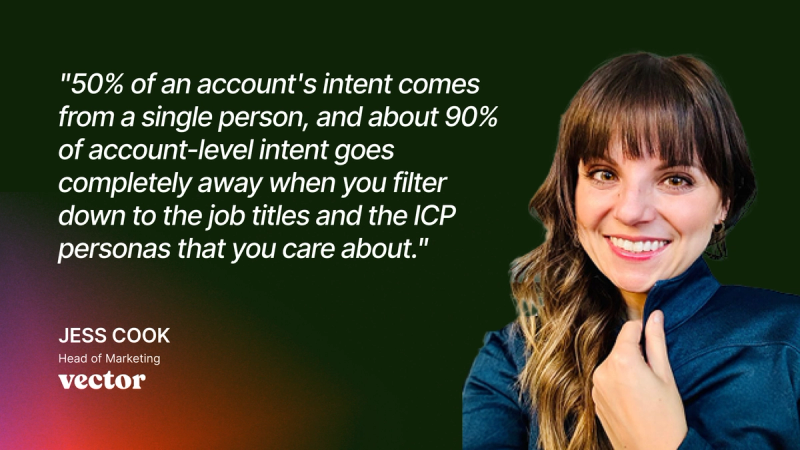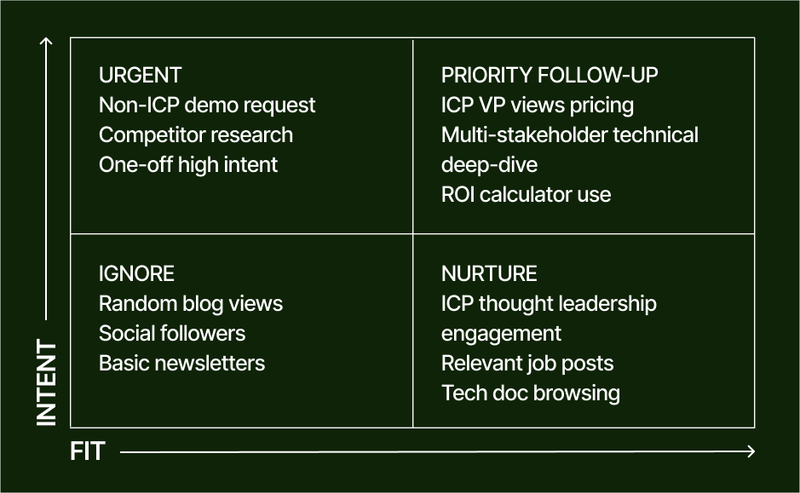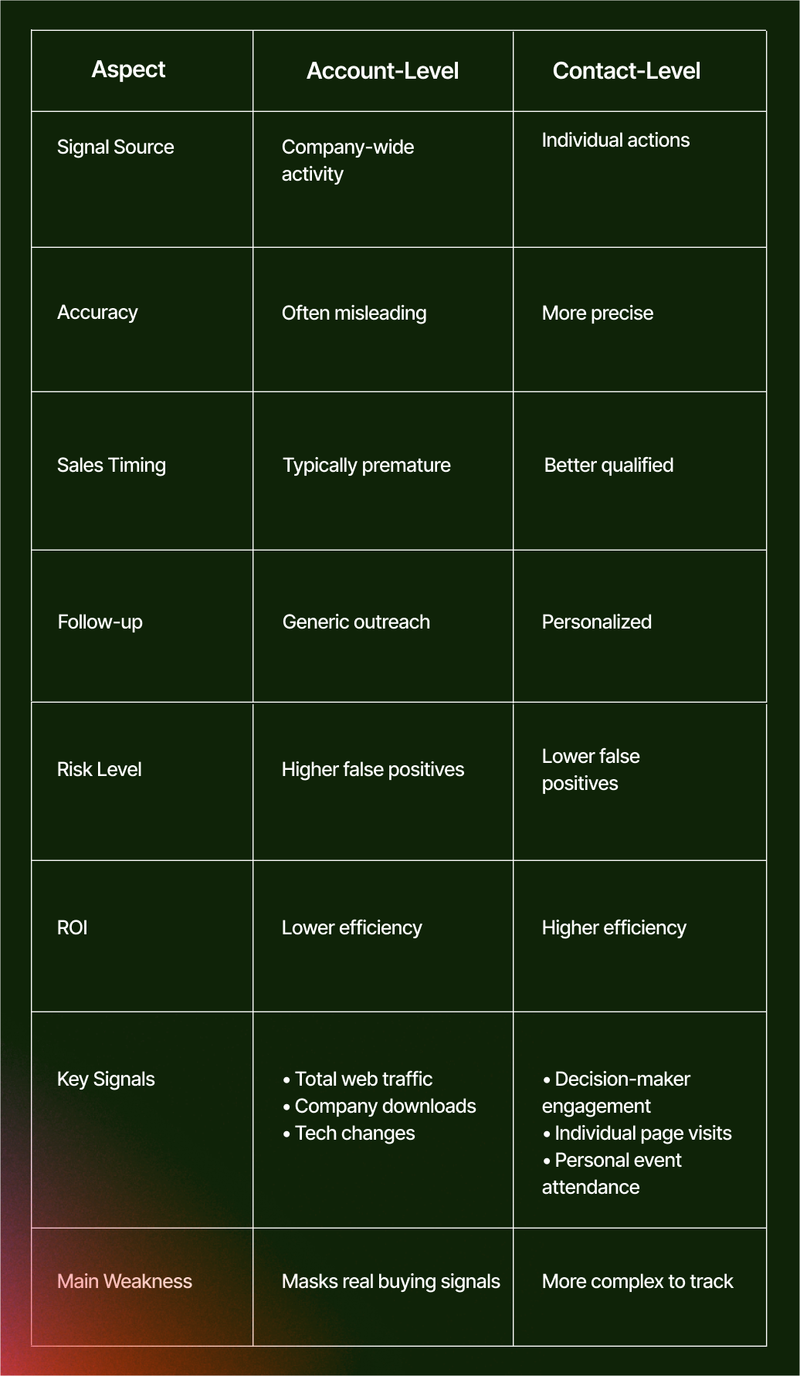Navigating the Buying Signal Wilderness

Table of Contents
Maximize Your Marketing ROI
Join 10,000 other marketers already getting the best tips on running engaging events that boost pipeline and create raving fans.
The year is 2015. A prospect visits your pricing page. You confidently mark them as sales-ready.
If only things were still that straightforward.
Fast forward a decade and we are drowning in data. Between intent platforms, engagement metrics, and an endless stream of digital breadcrumbs, demand gen experts find themselves in what DemandLoops founder Kaylee Edmondson describes as "signal purgatory."
That overwhelming state where you have too many signals but no clear path to action.
Welcome to the signal overload era
Does this scene feel familiar? You're staring at your dashboard, watching the engagement data roll in. Company A downloaded three whitepapers this week. Company B's whole engineering team just showed up at your webinar. Meanwhile, your ideal customer at Company C has been stalking your LinkedIn content for months.
They're all showing intent... right?
Not so fast. Our recent Goldcast poll revealed that "identifying real buying signals" is the number one challenge marketers face when using intent data. And it makes sense — the B2B buying journey has become increasingly complex, with more stakeholders, longer cycles, and endless ways to engage with your brand.
As a marketer, you’re a detective in a world where everyone leaves their fingerprints everywhere. Sure, there's more evidence than ever, but which prints actually matter? Which ones lead to your next big deal? 🔎
In this first chapter B2B Marketer’s Survival Guide, we'll help you cut through the noise and develop a clear framework for identifying and acting on the signals that matter.
The evolution of demand gen
Remember when account-based marketing was the hottest thing in B2B? (Okay, it still is, but stay with us here.) The idea was simple: identify your target accounts, build personalized campaigns, and watch the magic happen.
Not anymore. As Jess Cook, Head of Marketing at Vector, points out:

Let that sink in for a minute.
We're seeing a fundamental shift from pure account-based marketing to what we might call "contact-based marketing." It's not enough to know that Company X is showing interest — you need to know exactly who at Company X is raising their hand and how they fit into your ideal customer profile.
“You're much better off trying to define intent at the contact-level because to say that a whole company has intent when it’s potentially one person showing half of that intent, it just doesn't make sense.”
The noise factor
Here's where things get interesting (and by interesting, we mean challenging). The amount of data available to B2B marketers has exploded. On any given day we're tracking:
- Website visits and content downloads
- Social media engagement
- Event attendance and participation
- Third-party intent signals
- Product usage data (for PLG companies)
- Technographic changes
- Hiring patterns
- ...and about a million other data points
We've got more information than ever, but separating the signal from the noise? That's becoming an art form.
The real question isn't "Do we have enough data?" (trust us, you do). It's "How do we make sense of all this information in a way that actually drives revenue?"
From signals to strategy: a modern framework
If you've been nodding along so far, you're probably thinking, "Great, you've described my daily pain in excruciating detail. Now what?" This is where Alex Lindahl's "signals over segments" methodology comes in.

As GTM Engineer at Clay, Alex keeps it simple but powerful: "It's all about signals over segments — what are those unique signals that are specific to your ICP and personas? But also what's happening around those people or companies, and their environment internally?"
The signal-intent matrix
Not all signals are created equal.
Experts like Kaylee recommend embracing signal prioritization as the next frontier in B2B marketing. As she puts it: "The next magic is really gonna get to signal prioritization. It's one thing to walk in and identify core signals. It's another thing to be running thirty, fifty, a hundred plays against a matrix of signals."
We can plot them on two axes:
- Level of intent (how likely is this to indicate real buying interest?)
- Level of fit (how well does this match our ICP and target personas?)

High intent + high fit? That's your sweet spot. These are the signals worth dropping everything for. But here's where it gets interesting — sometimes a lower-intent signal from the perfect contact is more valuable than a high-intent signal from the wrong person.
Avoid random acts of marketing (a.k.a. RAM 🐏) and pay attention to both intent and fit.
The rise of custom signals
One size definitely doesn't fit all here. While some signals are universal (like demo requests), the most powerful signals are often industry-specific. For example, if you sell developer tools, your high-intent signals might include:
- A company posting multiple engineering roles
- Their CTO engaging with technical content
- Recent funding announcements
- API documentation visits
The key is identifying the unique combinations of signals that matter for your specific market and solution.

When analyzing your successful deals, ask yourself these key questions to identify your most reliable buying signals:
- What patterns consistently appear before a deal closes?
- Which early signals preceded your biggest wins?
- What combination of indicators most reliably predicts a purchase?
- How far in advance do these signals typically appear?
- Which stakeholder actions tend to signal serious buying intent?
- What engagement patterns differ between won and lost deals?
- Are there specific content types or topics that winning prospects engage with?
- Do successful deals share common acceleration triggers?
- Which signals have the highest correlation with actual revenue?
- What sequence of signals most often leads to a closed deal?
The answers to these questions will help you build a signal detection framework tailored to your business and buyer journey.
Making it real: tactical implementation
Theory is great, but let's get practical. How do you actually put this signals-first approach into action?
Start with your wins
Before you dive into new tools or fancy automations, take a step back and look at your recent wins. We're talking about your best customers — the ones who bought quickly, expanded their contracts, or become your biggest advocates.
What signals did they show early on? Maybe it was:
- Multiple stakeholders attending your events
- Specific content consumption patterns
- Engagement with particular features during trials
- Hiring patterns or org changes
This win/loss analysis isn't just a nice-to-have — it's your blueprint for future success.
Automate your signal detection
Once you know what signals matter, it's time to set up systematic ways to catch them. This is where tools like Clay come in handy. You might set up automated workflows to track:
- Job posting changes at target accounts
- Technology stack updates
- Funding announcements
- Leadership changes
- Engagement spikes across channels
The key is creating a signal detection system that alerts you to the right things at the right time — without overwhelming you with noise.
Score your signals
Not every signal deserves the same response. Consider creating a simple scoring system:
- High intent + high fit = Immediate action required
- High intent + low fit = Worth investigating
- Low intent + high fit = Add to nurture
- Low intent + low fit = Monitor only
A simple rubric helps you prioritize your response and ensure you're investing your time where it matters most.
Bringing it all together: alignment & operationalization
You've got your signals identified and your systems set up. Now comes the crucial part — making sure the right people get the right information at the right time.
The marketing-sales handoff
As Jess explains, marketing is better positioned to nurture and validate early signals. By holding onto leads longer, marketing can:
- Properly qualify the interest
- Ensure signals are truly indicating buying intent
- Prevent sales from being overwhelmed with premature leads
Think about it. How many times have you seen a lead get passed to sales too early, only to have them ghost or get annoyed by aggressive follow-up?
When marketing rushes to hand off leads before they're truly ready, it not only wastes valuable sales time but can actually damage those carefully cultivated prospect relationships.
Real-time signal activation
When you do spot those perfect high-intent, high-fit signals, speed matters. Set up two types of Slack notifications to keep teams aligned and informed:
- Real-time intent alerts: Create dedicated Slack channels for high-priority signals with instant notifications when:
- Target accounts visit pricing pages
- Multiple stakeholders register for events
- Key decision-makers engage with bottom-funnel content
- Competitive comparison content gets downloaded
- Weekly intent digests: Schedule automated weekly updates in Slack showing:
- In-pipeline accounts showing renewed or increased intent
- Out-of-pipeline accounts suddenly displaying buying signals
- Accounts with multiple stakeholders showing engagement
- Historical engagement trends and patterns
Here are some examples of how your automations might look:
- A target account's CTO views your pricing page? → Instant alert to the assigned AE
- Multiple stakeholders register for your webinar? → Notification to your events team
- A key account starts engaging with competitor comparison content? → Alert to your customer success team
With the right signals, you can tell the right revenue story.
“I like to be kind of a voice of reason for how signals and orchestration as a whole has helped us earn the ear and earn the time of this account. And then ultimately, how it helps us close or not close and in that case learn something from it that we can feed back into our model for future accounts,” explains Kaylee.
The feedback loop
Here's where many signal detection programs fall apart — they forget to close the loop. Set up regular check-ins between marketing and sales to validate which signals are actually leading to revenue. Ask questions like:
- Which signals consistently predict deals?
- Are we missing any early indicators?
- What patterns are we seeing in lost deals?
According to Alex, the key is to continuously experiment and iterate on your signal detection strategy, since what works today might not work tomorrow:
"You're going to be running certain go-to-market plays over time, and those have a shelf-life because then everyone else starts doing those plays and they become less potent. By continuously experimenting with the signals and the plays that go with those signals, you can find surprising pockets of go-to-market alpha. You apply that, run with it for a certain period of time, then continually experiment."
Making it stick
Remember, this isn't a one-and-done process. The B2B landscape keeps evolving, and so should your signal detection strategy. Schedule quarterly reviews to:
- Assess signal accuracy
- Update scoring models
- Refine automation workflows
- Adjust handoff timing
Closed-won is always going to be a really strong signal, but it’s important to have a culture of experimentation to discover the contact-based moments that got you there.
Key takeaways & next steps
- Successful signal detection requires moving beyond broad account-based approaches to focus on individual buying signals that truly indicate purchase intent.
- Tip: Start by analyzing your last 5-10 closed-won deals. Map out the specific signals that preceded each purchase to identify your most reliable buying indicators.
- The modern signal detection landscape demands both systematic processes and human intelligence — automate what you can but keep the human touch for interpretation and response.
- Tip: Create a simple signal scoring matrix (intent level × fit) to help your team quickly prioritize and act on the most promising signals.
- Signal detection is an iterative process. Regular collaboration between marketing and sales ensures you're catching the right signals and handing them off at the optimal moment.
- Tip: Schedule monthly signal validation sessions with sales to review which signals are actually converting to revenue and adjust your framework accordingly.
Ready to put this into action? Start by auditing your last five closed-won deals. What signals did you miss? What patterns could you have spotted earlier? Your next big opportunity might be hiding in plain sight — you just need the right lens to see it.
Ready to step up your game?
Transform Your Video Marketing with AI
Stay In Touch
Platform
Resources
© 2025 Copyright Goldcast, Inc. All rights reserved.





 Upcoming Events
Upcoming Events Event Series
Event Series On-Demand Events
On-Demand Events

